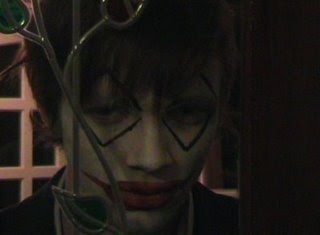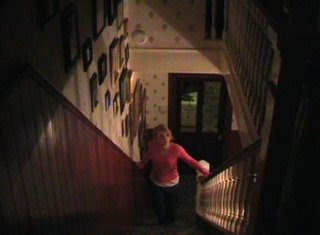
Informal Evaluation
From my own view point I think the project did create a fearful atmosphere for the audience, with our knowledge and research of horror films we were able to use the idea’s in an effective way. For example, the use of a clown as the stereotypical villain, and the use of camera shots, such as the canted angle we used which showed the characters as being confused or disorientated at that time in the sequence. I feel we created a sense of fear and created enigmas with the use of lighting, flashbacks, camera angles and diegetic and non-diegetic sound. However to have created a more effective sequence I feel we could have used shorter shots and told different parts of the film rather than just the one narrative throughout which would have developed more enigmas and made the viewer more enticed to watch the whole film.
Evaluation
For the AS Media coursework, my partner Jack and I were required to create an opening sequence of a film. We decided to create the opening to a horror film. We both researched and analysed opening sequences to horror films and researched other elements to develop a story for our horror film. We brought our research and findings together to begin to assemble our project.
I analysed an opening sequence to a popular horror film,
Conventions of our media project

As we both had most knowledge of teen preferences of films, and knew what would appeal to teens we favoured a horror opening sequence as we were more educated in this area having watched many ourselves. Between us we could use the information we knew and try to produce a similar product which would invoke fear in the audience. We decided to use as many key conventions of horror films, for example, the vulnerable screaming. We also used conventional camera angles, such as canted angles, high and low angle shots, over the shoulder and point of the view shots as it gives a sense of the victim being followed.

We thoroughly thought out the camera angles and both agree we have used them effectively to raise fear into the audiences minds, which has been commented on by the audience in a positive way.
Social Groups
We have presented two social groups in our sequence from the horror film world, the victim and the villain or otherwise known as the antagonist.
The Antagonist
In horror films there is usually only two different types of antagonists; they can be p
 resented as human, where they can be seen as normal yet in general are mentally twisted and have had some sort of terrible past that makes them progress into villains or just simply insane such as in Saw or Scream. However sometimes are seen as being perfectly normal yet as the film commences we see their breakdown progress as the film does, as seen in The Shining and Psycho.
resented as human, where they can be seen as normal yet in general are mentally twisted and have had some sort of terrible past that makes them progress into villains or just simply insane such as in Saw or Scream. However sometimes are seen as being perfectly normal yet as the film commences we see their breakdown progress as the film does, as seen in The Shining and Psycho.The second type is seen in psychological horrors, where the circumstances of the story are seen as being unrealistic yet portrayed in a realistic way it is then believable for the audience. This can be seen in such films as; Silent and Jacob’s Ladder.
We decided we would represent our antagonist as a Clown, yet at first he is seen to be more human at the beginning of the sequence, although he appears to come from nowhere. This is used in other horror films to easily scare the audience. Our antagonist presents some conventions of serial killers, his disturbing look (which is based on the Joker’s look from Batman) which is purposely juxtaposed with the suit he is wearing, which is to represent his twisted mind, his refined look yet psychotic mind, portrayed by his facial makeup. Other conventions presented are his capability of disappearing quickly and his silent nature. The purpose of introducing the Clown in the opening sequence was to set up enigmas, so the audience would question who he was and why he is at the house and also, most importantly what he is going to do.
The Victim
Often the victims used in horror film opening sequences are teenage girls, who are seen as being young, innocent and defenceless. To portray this in our character, I dressed in pink appr
 oach to unusual happenings is for the characters to go looking themselves rather than leaving or getting help, they go alone into the danger, this behaviour is popular in horror/slasher films such as Scream and Halloween. The narrative is set in a usual situation, the victim is in a typical house, typical clothing, nothing not the norm about her, as the Clown watches and seems to stalk the young girl the audience, after seeing her innocence begin to feel sympathetic for her.
oach to unusual happenings is for the characters to go looking themselves rather than leaving or getting help, they go alone into the danger, this behaviour is popular in horror/slasher films such as Scream and Halloween. The narrative is set in a usual situation, the victim is in a typical house, typical clothing, nothing not the norm about her, as the Clown watches and seems to stalk the young girl the audience, after seeing her innocence begin to feel sympathetic for her.Distribution
For the film we have created Lionsgate Entertainment are a popular entertainment company who have produced many successful and award-winning films would be an ideal company to produce our film. The company have often taken risks in releasing films that are different to the type of film favoured by film viewers; therefore we think they would take a risk in distributing our film. They are responsible for the release of the four Saw films and most recently The Haunting in Connecticut.
Audience
Our opening sequence is aimed at teenagers and obviously may appeal to any horror film fanatics. This genre of film is aimed at both male and female yet it is alleged that horror films are mainly targeted at males. Both genders are focused on when producing the film with neither in main aim of attraction. Teenagers are an ideal target audience as they often attend cinema’s and are more likely to buy films then the older generation.
Key features of an opening sequence
To portray the correct messages to the audience we had to include several things to create a successful opening sequence.
We decided to present a short but obvious equilibrium at the very beginning of the sequence to easily disrupt the atmosphere. We see the babysitter putting the child to bed y
 et also have a sense of out of the ordinary in the air. This is where we begin to introduce enigmas and the narrative is disrupted. When the audience become aware of things going wrong we decided to then introduce the Clown. This is where more enigmas are addressed and the audience begin to question why he is there and why he is targeting the young babysitter. These enigmas entice the audience and keep them engrossed in the narrative.
et also have a sense of out of the ordinary in the air. This is where we begin to introduce enigmas and the narrative is disrupted. When the audience become aware of things going wrong we decided to then introduce the Clown. This is where more enigmas are addressed and the audience begin to question why he is there and why he is targeting the young babysitter. These enigmas entice the audience and keep them engrossed in the narrative.A convention in the setting of horror films is a large old looking house set at night,
 which we included a shot of at the beginning of the sequence. The costume and house decor convey the time the sequence is set, the house has a typical modern day look and all the general things that would be recognised by the audience.
which we included a shot of at the beginning of the sequence. The costume and house decor convey the time the sequence is set, the house has a typical modern day look and all the general things that would be recognised by the audience.Another common ideology used in horror films is the binary opposition in good and evil, presented through the characters; the babysitter being good and the Clown being evil. We communicated this by the set up of an obviously intended attack (yet still unknown by the audience) from the clown to the young girl. This is present in other films such as Halloween with Jason and the babysitter (Jamie Lee-Curtis).
Music is more commonly than not used to build dramatic tension, we adjusted the volume level to be louder at more dramatic building times yet quieter at times where dialogue was spoken as this helped to develop the narrative.
We used several shots and angles in our cinematography, this helped increase tension
 and fear. We used a canted angle when the babysitter walked into the bed room; this was to present to the audience the characters confusion of the goings on at that moment in time. Our project followed one character in particular so we were able to successfully achieve continuity editing throughout.
and fear. We used a canted angle when the babysitter walked into the bed room; this was to present to the audience the characters confusion of the goings on at that moment in time. Our project followed one character in particular so we were able to successfully achieve continuity editing throughout.Technology
Whilst creating the sequence we were able to develop our skills of using a camera. Through the process of creating our sequence we under went a preliminary task, this gave us the opportunity to make mistakes we could then learn from to perfect our opening sequence. We also used the internet for research on other horror films and for ideas for our own film. We also created a blog where we placed clips and research, which we could both access if unable to reach each other, which was a great aid in developing the project.
































